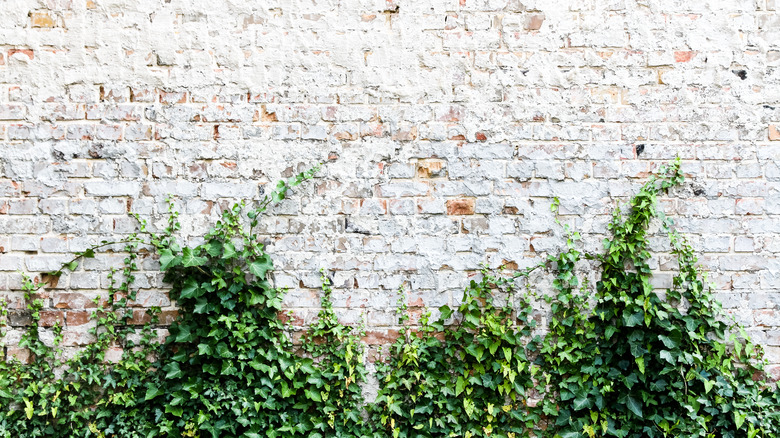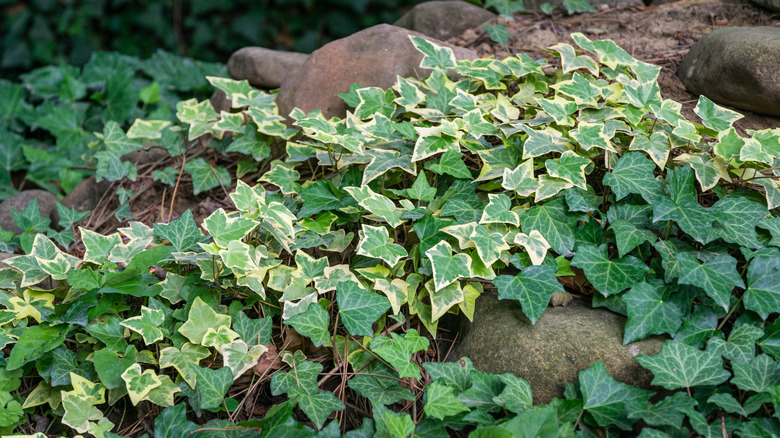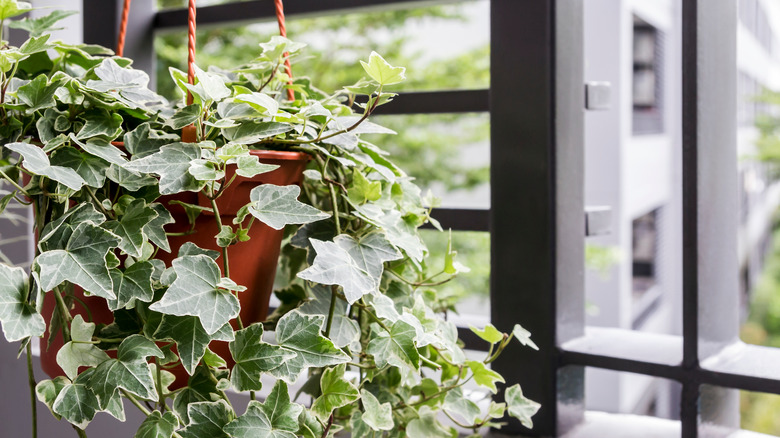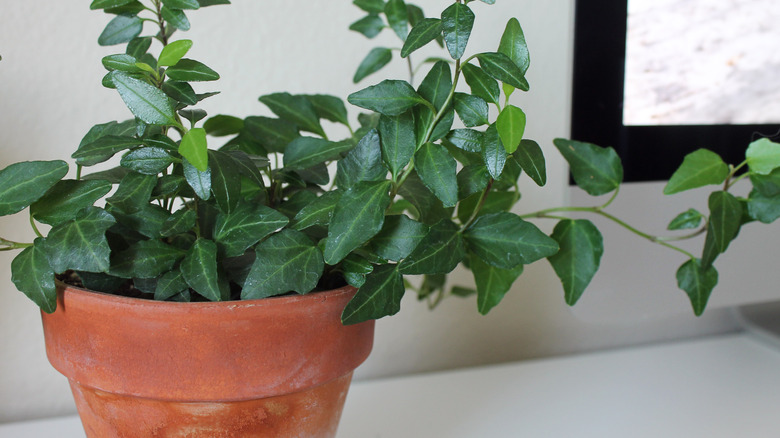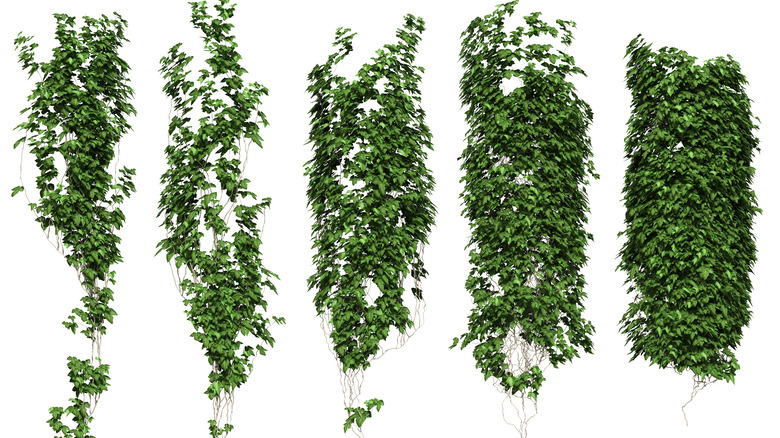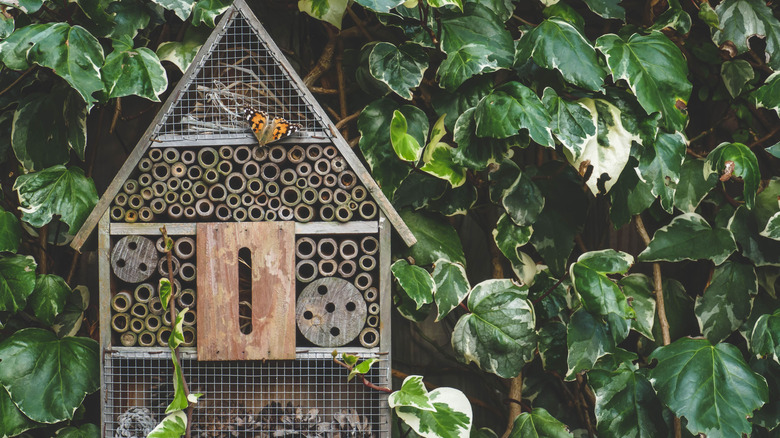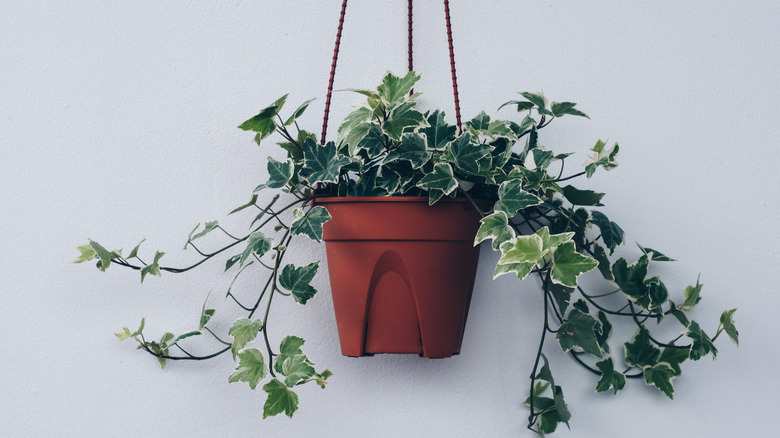How To Successfully Grow English Ivy
Thanks to its romantic look and easily recognizable leaves, English ivy (also known by its scientific name, Hedera helix) is a charming perennial. Although the plant may eventually produce tiny greenish blooms, it is primarily grown for its evergreen leaves. Classified as a woody vine, you can plant English ivy horizontally (it spreads as much as 15 feet and grows up to 8 inches tall when on the ground) or as a climber that can reach up to 80 feet.
As The Spruce notes, English ivy can be grown both indoors and outdoors. An ideal way to grow it indoors is in hanging pots that allow the vines to trail in a beautiful, casual way. Outside, English ivy's ability to spread quickly makes it ideal for ground cover where there are difficult-to-plant gaps in the landscape.
But there are some downfalls to this type of vine. In many areas it is considered an invasive species, and you should check with your local government to find out if you're allowed to plant English ivy. Also, while dreamy images of historic homes covered in ivy may come to mind, the ivy's ferocious aerial roots can pierce mortar fissures and eventually tear stones and bricks away, so plant it a safe distance from any buildings on your property.
How to use English ivy in the house or the garden
English ivy is mainly used to cover the ground, terrace grills, and walls, making it a favorite to grow in the garden since it fills in gaps and gives the yard a natural, healthy appearance. This plant is not difficult to cultivate, but it does require some attention and care. Most ivies you can grow as houseplants are cultivars of English ivy: You can take a cutting from ivy in your backyard and plant it in a pot inside, where it will look beautiful cascading over the sides.
One of the most fantastic things about growing ivy indoors instead of the outside is that you won't have to worry about it taking over your garden or harming your house's roof. Herbalists often use the English ivy plant to cure respiratory problems, which is a good enough reason to bring a pot indoors if you haven't already. Ivy isn't nearly as tough indoors as outdoors, because, as Gardner's Path explains, the dry air and consistent temperatures irritate them. That means you'll have to offer your English ivy a little extra attention indoors in order to help it thrive.
How to grow English ivy
Gardner's Path says there are multiple options for growing English ivy indoors. As noted earlier, it can be as simple as planting an ivy cutting in a pot. Another option is propagating the seed from your outdoor English ivy's berries. A slightly more complicated way is layering, which involves burying or covering a part of the stem to create a new plant. Finally, you can simply buy a seedling or small plant from a nursery.
However you choose to grow your English ivy, there are some key aspects to ensuring your vines grow to be full and healthy. Bloomscape notes that light is a critical aspect of indoor ivy plant care: Bright, indirect light is ideal. Direct sun will cause the foliage to burn. If there isn't enough light, the ivy will become leggy and sparse, as well as more vulnerable to pests. Placing the English ivy near a north- or east-facing window is ideal. Another option is placing it near a fluorescent light, which will do the trick.
How to care for your English ivy
A great English ivy care tip is to always inspect the soil before watering your ivy. Since it enjoys a moist, but not wet, environment, wait until the soil is a bit dry to the touch on top before watering your English ivy plant again. Don't wait too long, though, advises Indoor Plant Guides, as the ivy doesn't do well in drought conditions. Also, ensure that your plant has good drainage because it doesn't like standing water or too-damp soil.
Moreover, ivy plants should be fertilized regularly as part of their care: Treat your ivy with a water-soluble, nitrogen-rich fertilizer once a month in the spring, summer, and fall. However, don't fertilize your English ivy in the winter because it is dormant, and the fertilizer may cause more harm than good. Lastly, the leaves of ivy houseplants benefit from being washed regularly to remove dust and bugs. Simply set your ivy plant in the shower and let the water run over it for a few minutes to clean it. If the plant has a major pest infestation, you may need to spray closer to it to help kill all of the pests.
English ivy varieties
According to HGIC, there are hundreds of cultivars of English ivy, and the varieties run the gamut in terms of size, color, and shape. They include miniatures, which are small plants with leaves under 1 inch long; oddities, which are vines with distorted stems or leaves, or bushy upright growth; and variegateds, which have leaves of either multiple colors or are a different color than green.
The many charming names of the cultivars often illustrate what makes them distinct. For example, the Buttercup variety has pale green leaves in shade, but they are bright yellow in sun. The Fluffy Ruffels variety has small, curly leaves with frilled margins. And Gold Heart has heart-shaped leaves with a splash of creamy yellow in the center. Even though there are so many varieties, one thing that all English ivy plants have in common is their ability to grow quickly and climb on trees and other structures.
Is English ivy toxic?
English ivy may be lovely, but use it with caution, as it's dangerous to humans, animals — such as cattle, dogs, and cats — and the ecological system. According to the ASPCA, some symptoms of English ivy ingestion include vomiting, abdominal pain, hyper-salivation, and diarrhea. With humans, Hedera helix can induce an allergic skin reaction (although cases are few). Ingestion of berries or leaf material in small quantities may just cause mild gastrointestinal distress, but if you ingest a large amount of ivy then there is potential for breathing difficulties, muscle weakness, coordination problems, fever, hallucinations, and coma.
The plant also poses a danger to the environment. English ivy is a highly invasive shrub that infests woodlands and suffocates native vegetation. If not controlled, English ivy creates shaded areas that interfere with seed growth. The vine also acts as a moisture trap, keeping tree bark damp and putting trees at risk for bacterial infestation.
How to repot English ivy
These plants are sometimes grown in hanging baskets and allowed to tumble over the sides. Given their invasive nature, this is a practical way to grow the vines for their aesthetic value without worrying about them spreading out of hand. You can repot small English ivy plants once a year and larger plants every two years; however, ensure you always repot with fresh potting soil to guarantee appropriate nutrition. On the other hand, you can rejuvenate older plants by simply refilling the soil in the same pot. According to SFGate, the English ivy needs to be repotted when its roots wrap around itself.
To repot the plant, clean a pot 2 inches larger than the one in which the ivy is now growing, ensuring it has drainage holes, and fill the pot one-third full with potting soil for houseplants. Turn the ivy pot over down and smack the rim against the table's edge. To avoid damaging the stems, move the plant away from the rim and get the root ball by gently pulling or teasing the roots away from the sides. Place the root ball in the center of the new pot, ensuring the roots are half an inch below the container's rim. Get a drainage tray and place the English ivy pot in it. Slowly water the plant until the water comes out of the drainage holes. Lastly, make sure to place the pot somewhere where the plant can receive lots of indirect sunlight.
